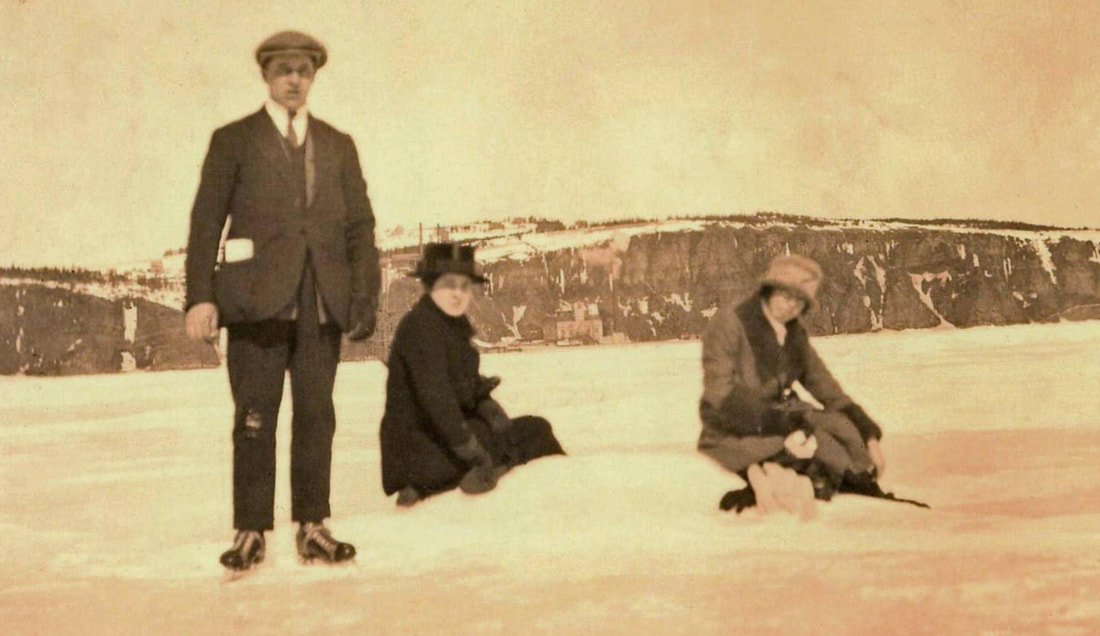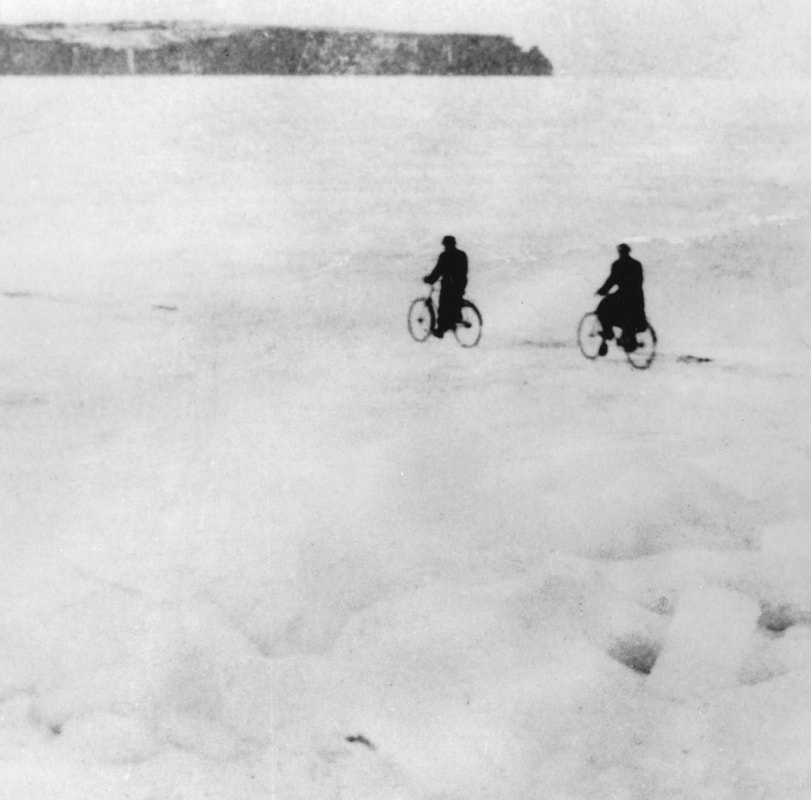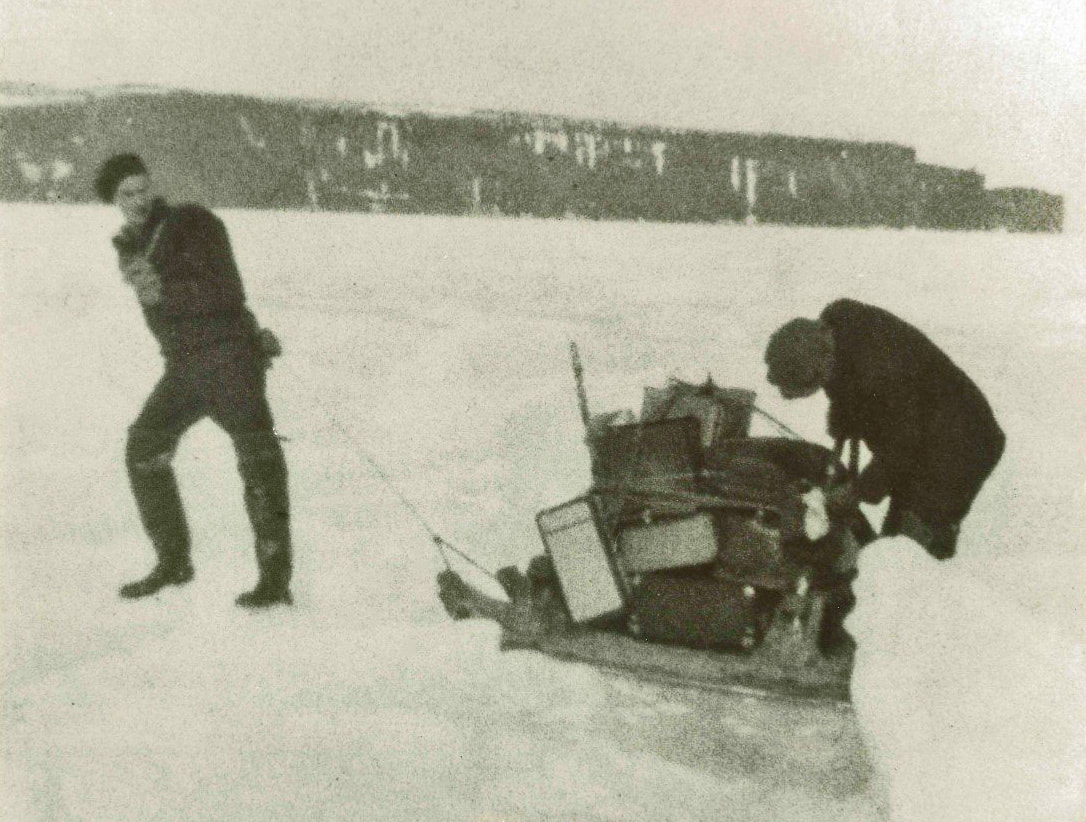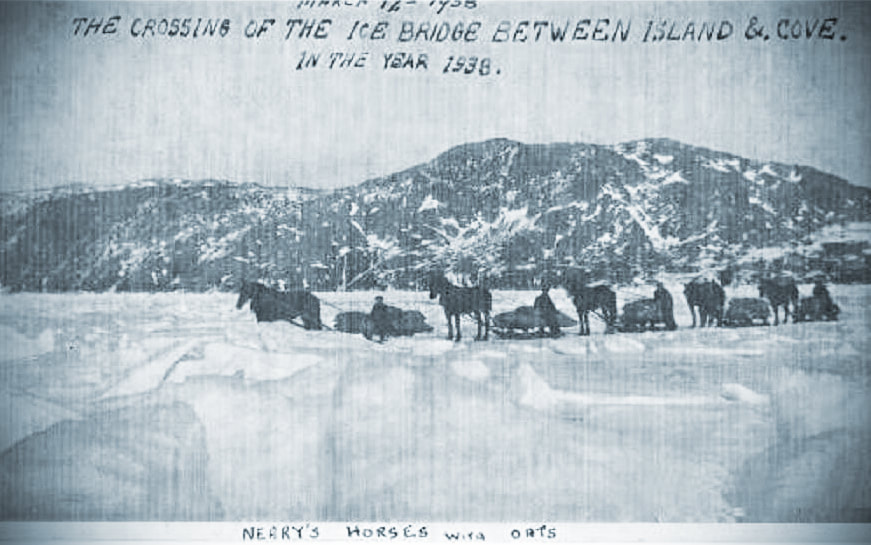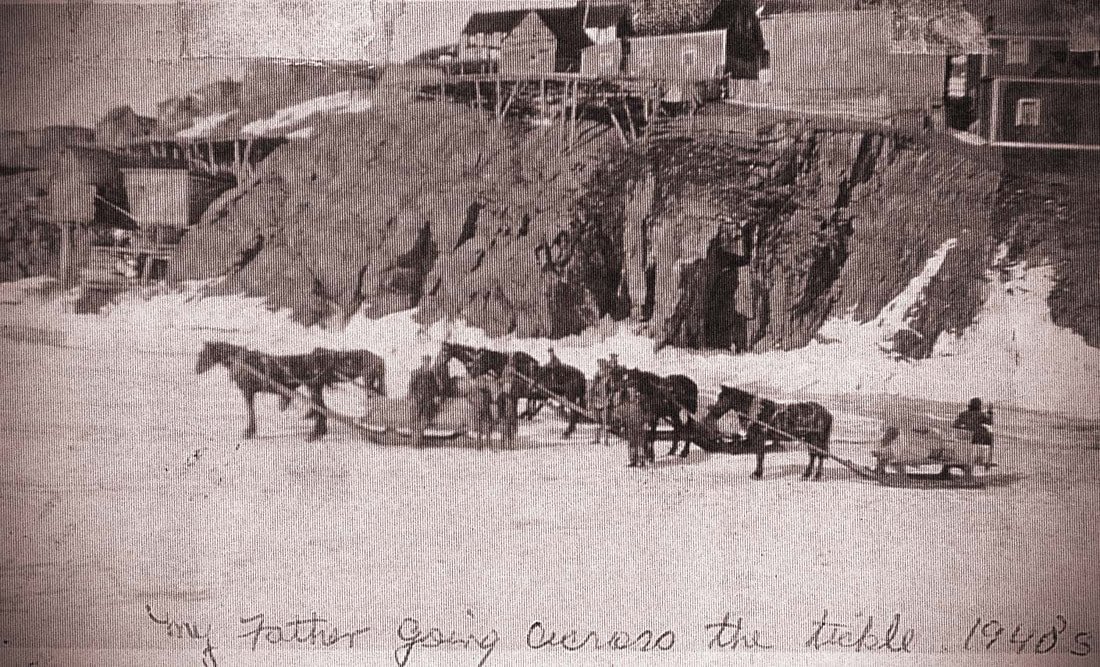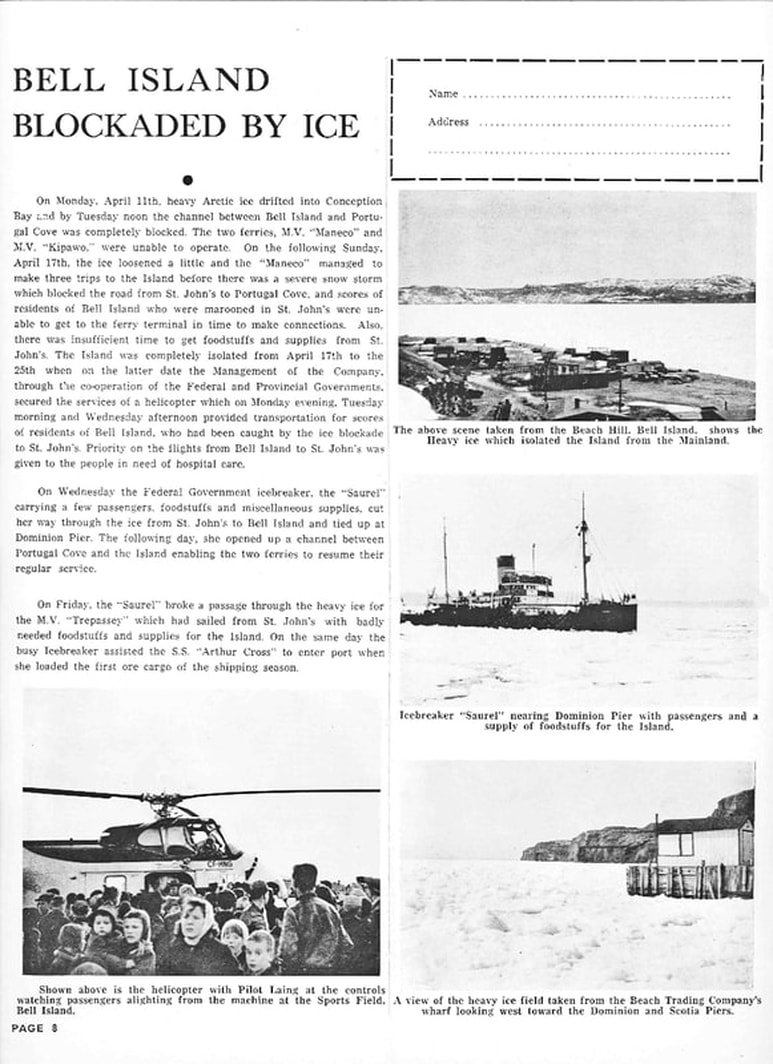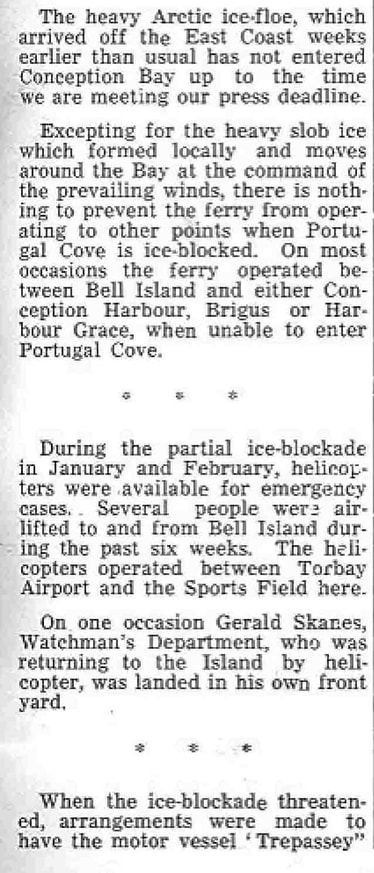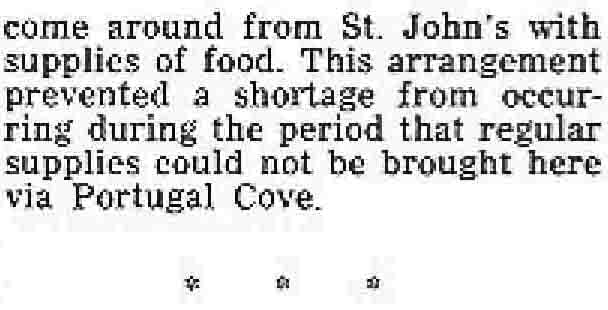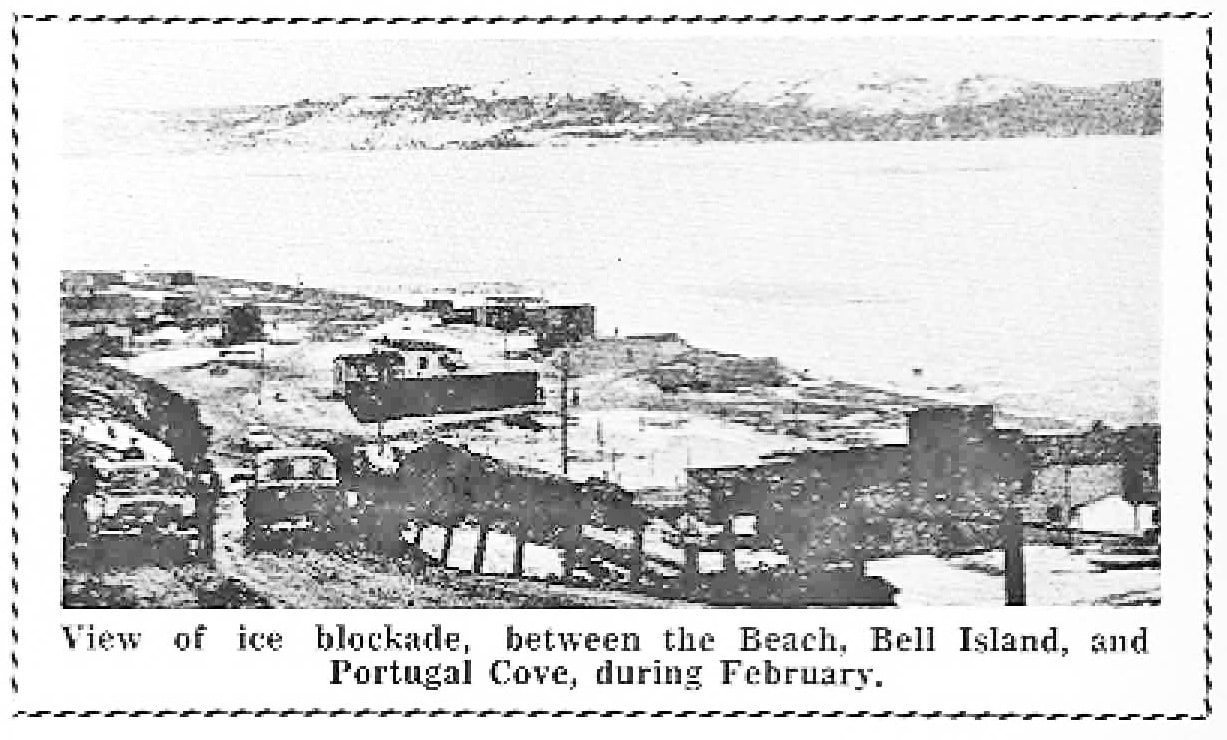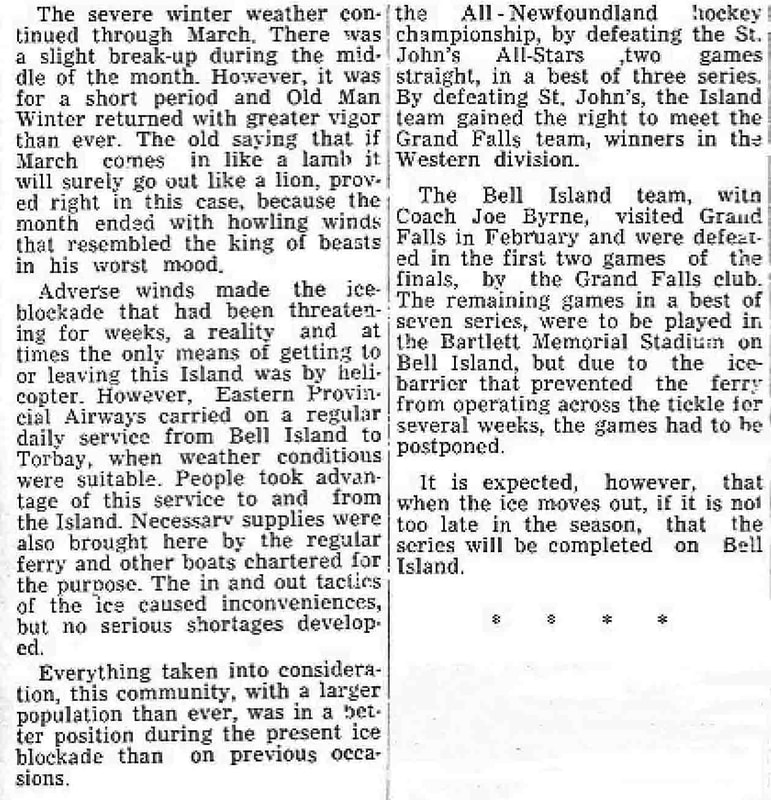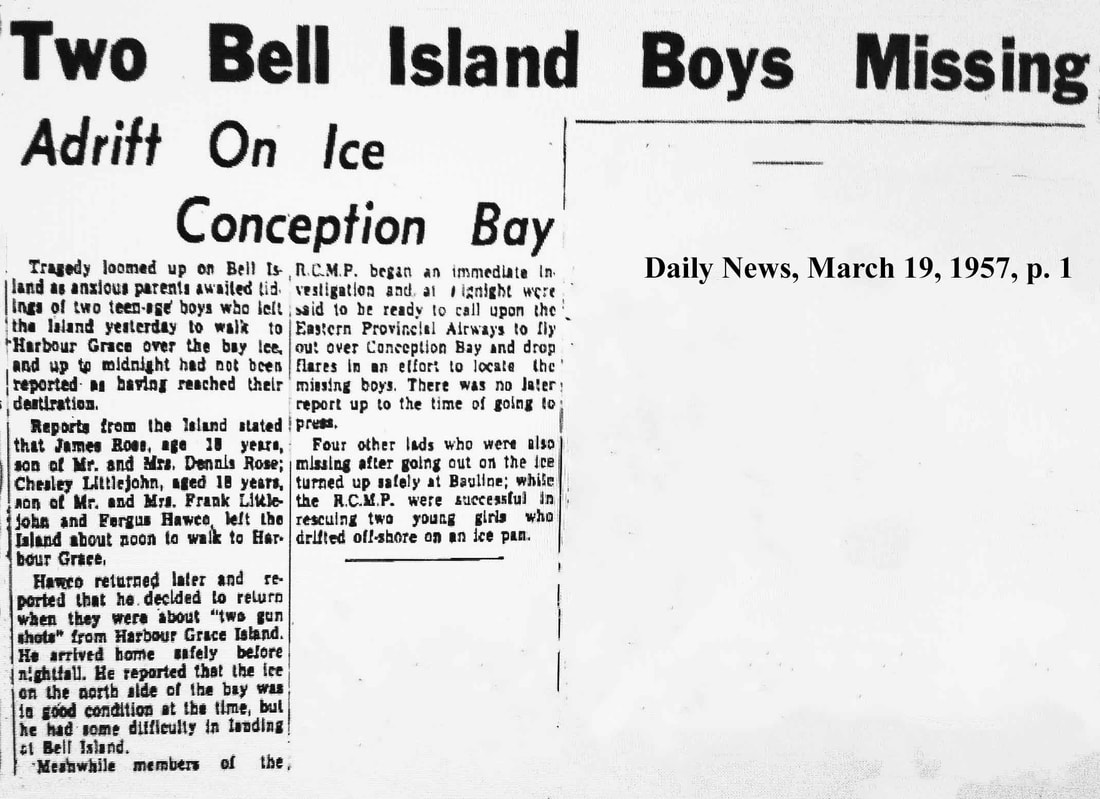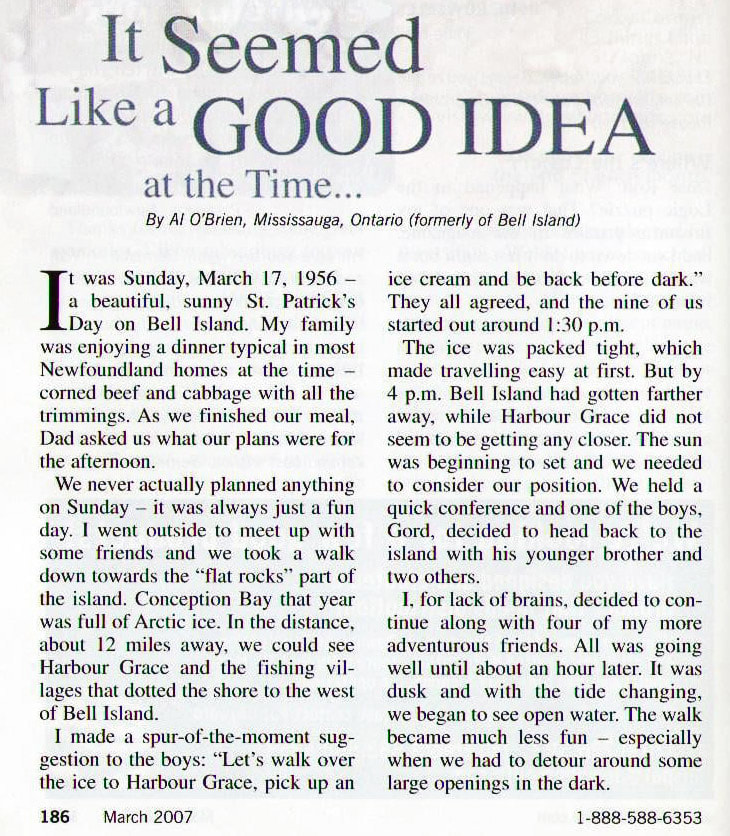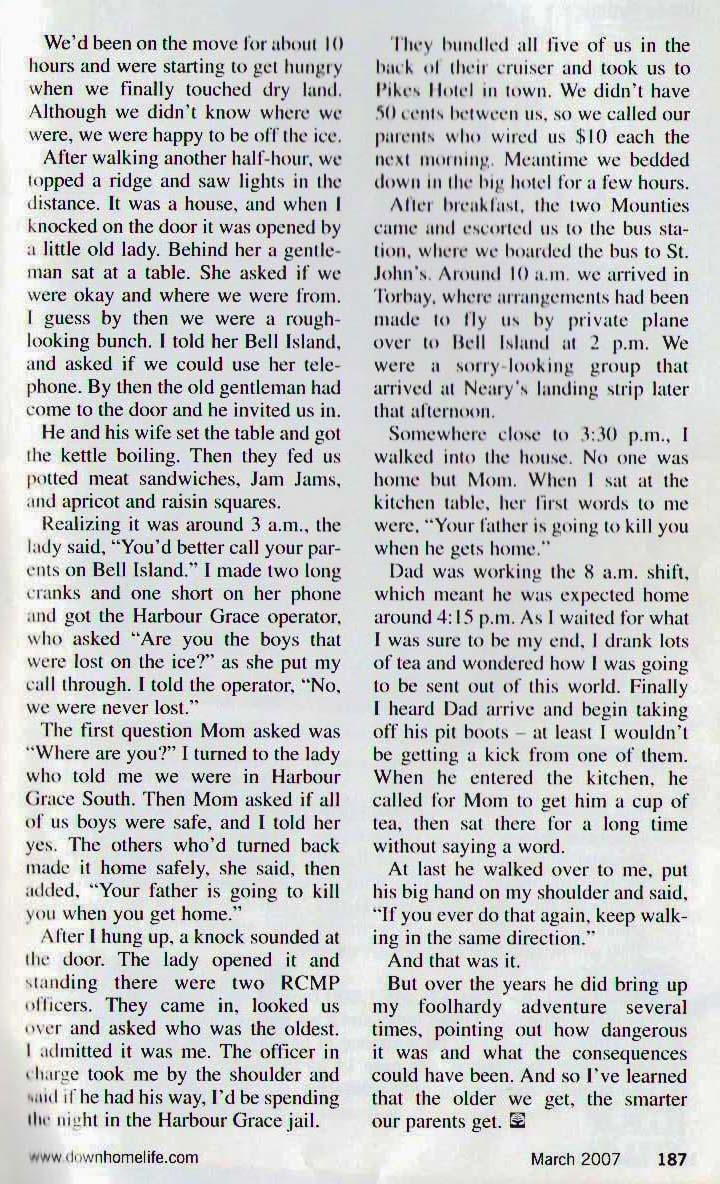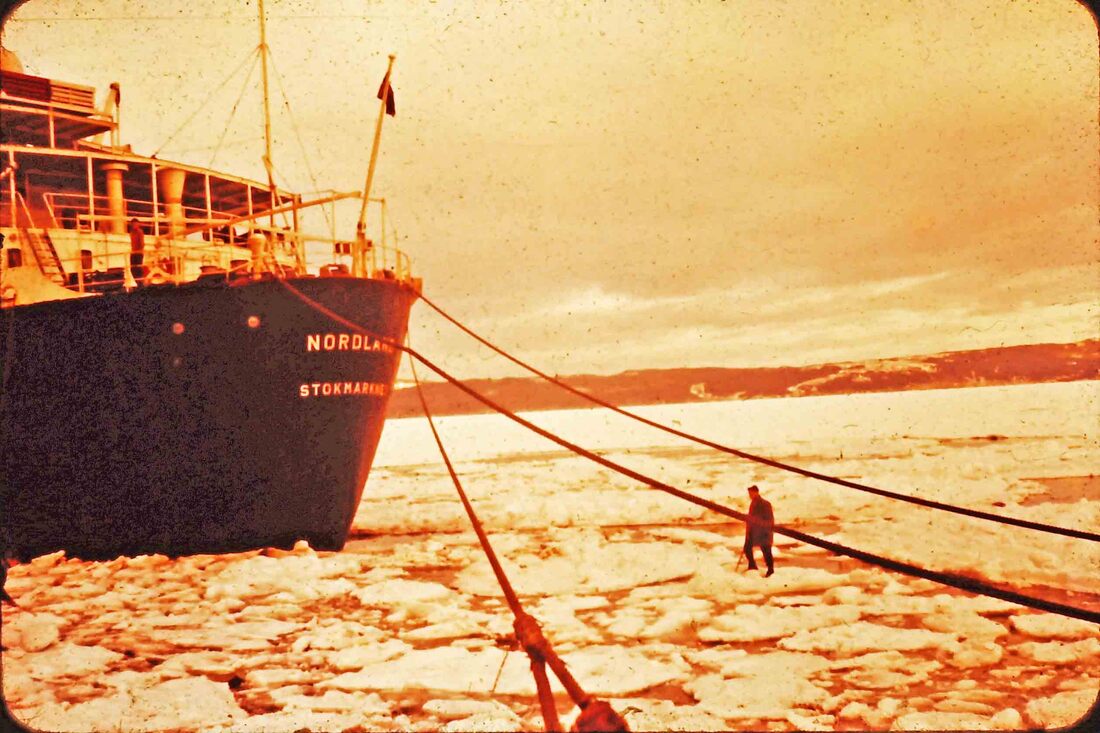HISTORY
TRANSPORTATION
FERRIES & THE TICKLE
TRANSPORTATION
FERRIES & THE TICKLE
ICE IN THE TICKLE
by Gail Hussey-Weir
Created April 14, 2021 / updated April 9, 2022
by Gail Hussey-Weir
Created April 14, 2021 / updated April 9, 2022
The shipping season in Bell Island mining history ran from about late April of one year through to late February or early March of the next. Arctic ice travelling down the Newfoundland coast and packing into the bays impeded shipping most winters during March and April. It would often pack so tightly into Conception Bay that some hardy residents would take it upon themselves to walk, or skate, or even ride bicycles across the Tickle between Bell Island and Portugal Cove. Komatik sleds would be hitched to horses to pull freight across when supplies ran low on the Island. Seals would also migrate south with the Arctic ice and men would take their chances on the ice to obtain fresh seal meat to help feed their families, a necessity during lean years.
The "ice blockade," as it was referred to, did not stop the pre-mining pioneer families from getting to St. John's to sell their livestock and buy supplies. In his memoire, "Belle Island Boyhood," first published in the Oregon Spokesman in 1949, Thomas Power recalled driving cattle across the ice when he was a boy in the 1890s:
When I was nine and my brother eleven, we were sent with steers (cattle) to the capital city of St. John's. They were necked together and we drove them two miles to the Beach and across the Tickle on the ice. That part of Conception Bay, really a part of the Atlantic Ocean, is three miles wide and sometimes freezes over. When we got to Portugal Cove, we drove the steers nine miles by road to the city. We wore knee-high rubber boots and when we arrived home that night, we had covered twenty-eight miles.
The "ice blockade," as it was referred to, did not stop the pre-mining pioneer families from getting to St. John's to sell their livestock and buy supplies. In his memoire, "Belle Island Boyhood," first published in the Oregon Spokesman in 1949, Thomas Power recalled driving cattle across the ice when he was a boy in the 1890s:
When I was nine and my brother eleven, we were sent with steers (cattle) to the capital city of St. John's. They were necked together and we drove them two miles to the Beach and across the Tickle on the ice. That part of Conception Bay, really a part of the Atlantic Ocean, is three miles wide and sometimes freezes over. When we got to Portugal Cove, we drove the steers nine miles by road to the city. We wore knee-high rubber boots and when we arrived home that night, we had covered twenty-eight miles.
|
You can read Thomas Power's memoire by clicking the button on the right >>>>>
|
On March 20, 1897, The Daily News reported that "20 horses from Bell Island were on George Street with loads of produce such as potatoes, turnips, cabbage, etc., which sold at reasonable prices. The finest potatoes which came to the city these months past came from Bell Island this morning." The story went on to say that the Tickle had become blocked with ice in February and people crossed with horses to the mainland on the ice.
On February 28, 1913, a hockey team from St. John's were invited to Bell Island for a game. They drove across on the ice from Portugal Cove, but the ice broke up during the night and they had to be taken back to the mainland on the ferry, Mary, with their three horses. After partaking of refreshments at Joe Gosine's [in Portugal Cove], they tackled up their horse teams and drove to the City. (Source: Addison Bown, "Newspaper History of Bell Island," p. 39.)
Below are pictures and articles illustrating the ice in the Tickle over the years and how some people took advantage of it for recreation and travel. The first is of Charles and Ruth Archibald (left) and a friend out for a skate on Arctic ice that had packed into the Tickle c.1915. Photo courtesy of their granddaughter, Ruth Archibald.
On February 28, 1913, a hockey team from St. John's were invited to Bell Island for a game. They drove across on the ice from Portugal Cove, but the ice broke up during the night and they had to be taken back to the mainland on the ferry, Mary, with their three horses. After partaking of refreshments at Joe Gosine's [in Portugal Cove], they tackled up their horse teams and drove to the City. (Source: Addison Bown, "Newspaper History of Bell Island," p. 39.)
Below are pictures and articles illustrating the ice in the Tickle over the years and how some people took advantage of it for recreation and travel. The first is of Charles and Ruth Archibald (left) and a friend out for a skate on Arctic ice that had packed into the Tickle c.1915. Photo courtesy of their granddaughter, Ruth Archibald.
A tragedy occurred in 1921. The Daily News reported that "the whole of Conception Bay was frozen over on February 2. Only one mail was received at the Island in a fortnight and that was brought across the ice from Horse Cove" [St. Thomas']. The mines were only working four days a week because of poor markets and people had to get food however they could. "The ice surrounding the Island tempted residents to go out and hunt for seals and birds. The tragedy happened on February 19 and threw a deep gloom over the whole Island. 25-year-old Theodore (Ted) Squires, a DISCO staff member, was driven off on the ice while bird hunting with two other men. They had left the Island together near No. 6 Slope, but Squires left the other two and headed east. When the ice started to open up, the other two men headed back to shore at Freshwater Cove, but Squires was about two miles east by then and could not make it back to shore because of the open water. The police were notified and hundreds of men went to the cliff side to see if there was anything they could do, "but the ice had moved well off and darkness fell. Boats went off next morning, but no trace of the unfortunate man was ever found." The Kyle was sent out from St. John's in an effort to locate him, but the search was hampered by the heavy ice.
In 1923, the Tickle was frozen solid from February 8th to April 3rd. On the day before the ice blockade, the ferry, Othar, was only able to get half-way to Portugal Cove. She picked up 70 workmen from the edge of the ice and brought them to Bell Island. On February 23rd, men and horses came from Topsail to Dominion Pier for coal. They were caught in a storm of blowing snow on the return, but made it back without incident. The next day, men with horses crossed on the ice from Topsail, Kelligrews, St. Philip's, Portugal Cove, and even Pouch Cove, to get coal. On February 26th, the Dominion Pier had the appearance of a market place. There were about 50 horses and men on the Pier at one time, the largest number of horses seen there before or since in one day. These crossings on the ice continued right through March. The last horse to cross on April 3rd, before the ice broke up, returned to Lance Cove from Topsail carrying a cask of liquor to fill the scripts of a local doctor. (Source: Bown, p. 70.)
The Daily News reported that "Slob ice filled the Tickle on February 1, 1930 and the S.S. H.A. Walker could not get through to Portugal Cove. It was the earliest blockade for six years. The blockade lasted for a week and was relieved when a terrific gale on the night of the 8th broke up the ice."
A March 1933 item in The Daily News reported that "Heavy ice brought a bumper crop of seals into the bay in April. The event coincided with the 10-day idle period between mining operations, and the men took advantage of the good weather to venture out on the ice, where they walked as much as 18 miles to bring back the carcasses, which provided much-needed protein as well as pelts, that were sold to local merchants for much-needed cash."
In 1923, the Tickle was frozen solid from February 8th to April 3rd. On the day before the ice blockade, the ferry, Othar, was only able to get half-way to Portugal Cove. She picked up 70 workmen from the edge of the ice and brought them to Bell Island. On February 23rd, men and horses came from Topsail to Dominion Pier for coal. They were caught in a storm of blowing snow on the return, but made it back without incident. The next day, men with horses crossed on the ice from Topsail, Kelligrews, St. Philip's, Portugal Cove, and even Pouch Cove, to get coal. On February 26th, the Dominion Pier had the appearance of a market place. There were about 50 horses and men on the Pier at one time, the largest number of horses seen there before or since in one day. These crossings on the ice continued right through March. The last horse to cross on April 3rd, before the ice broke up, returned to Lance Cove from Topsail carrying a cask of liquor to fill the scripts of a local doctor. (Source: Bown, p. 70.)
The Daily News reported that "Slob ice filled the Tickle on February 1, 1930 and the S.S. H.A. Walker could not get through to Portugal Cove. It was the earliest blockade for six years. The blockade lasted for a week and was relieved when a terrific gale on the night of the 8th broke up the ice."
A March 1933 item in The Daily News reported that "Heavy ice brought a bumper crop of seals into the bay in April. The event coincided with the 10-day idle period between mining operations, and the men took advantage of the good weather to venture out on the ice, where they walked as much as 18 miles to bring back the carcasses, which provided much-needed protein as well as pelts, that were sold to local merchants for much-needed cash."
Below: Two men riding bicycles across the Tickle on Arctic ice, c.1935. Photo courtesy of Ingaborg Marshall.
A March 1937 article in The Daily News reported that "The ice blockade was a serious one that winter, lasting from the first of February until the middle of March. Crew members of M.S. Maneco, which was frozen in at Bell Island, brought the mail across from Portugal Cove on a catamaran whenever it was possible to do so. The ship had the contract for carrying the mail and the crew did their best in difficult circumstances to get it through. On February 26, the ice in the Tickle began breaking up under a heavy swell, resulting in dangerous conditions for those attempting to cross. Two men from Portugal Cove took two and one half hours to walk across after they both fell in several times. Seven others who came later had to be rescued by S.S. H.A. Walker which, luckily for them, came around the Cape with freight from St. John's. She brought the first cargo to reach Bell Island in a month. A quantity of goods was lost on the way across the Tickle when the swell broke up the ice bridge. However, the ice closed in again and for the next three weeks a steady stream of freight was transported across the ice by horse-driven or hand drawn sleighs or catamarans. The Grand Falls Cadets arrived in St. John's on March 7 to play a series of hockey games with the Bell Island boys, but could not get over owing to the ice conditions. Bay Roberts also had to cancel a visit to the Island for the same reason. The Maneco and Mary Smith did not get clear until March 11th.
Below: "Transporting Food in Suitcases Over Ice." Photo courtesy of Doris Bennett.
Below: "Transporting Food in Suitcases Over Ice." Photo courtesy of Doris Bennett.
The Daily News reported in 1938 that "A severe ice blockade was experienced in the winter of 1938. The ice came in as early as the middle of February and, for the next 45 days, the ferry service was discontinued. The Maneco left Portugal Cove on the 17th and it took her three days before she finally butted her way in to the Scotia Pier after being jammed or trying to force a passage through the frozen pans all that time. The port of St. John's was again blocked for the second consecutive winter. The harbour was frozen solid and hundreds were skating or playing hockey on its surface. On the 12th of March, a hockey game was seen in progress near Chain Rock. A 59-ton coasting schooner took 28 days to get from Grand Bank to St. John's owing to the ice blockade on the east coast.
Bell Island was completely surrounded by ice and a solid bridge across the Tickle enabled men and horses to move freely across. After the crew of the Maneco had finally found a berth at the Island, her crew took to the ice with a komatik and a team of dogs to carry the mail back and forth, thus carrying out their contract to deliver the mail. A parade of horses and slides, dog teams, catamarans and pedestrians crossed in a steady stream every day, making a well-worn path between the Beach and the Cove. Loads of provisions and goods of all kinds were freighted over the ice-pan highway. The hockey team walked across the ice on February 26 for the opening game of the Conception Bay series.
Below: Tom Neary "crossing the ice bridge between Bell Island and Portugal Cove, 1938."
Bell Island was completely surrounded by ice and a solid bridge across the Tickle enabled men and horses to move freely across. After the crew of the Maneco had finally found a berth at the Island, her crew took to the ice with a komatik and a team of dogs to carry the mail back and forth, thus carrying out their contract to deliver the mail. A parade of horses and slides, dog teams, catamarans and pedestrians crossed in a steady stream every day, making a well-worn path between the Beach and the Cove. Loads of provisions and goods of all kinds were freighted over the ice-pan highway. The hockey team walked across the ice on February 26 for the opening game of the Conception Bay series.
Below: Tom Neary "crossing the ice bridge between Bell Island and Portugal Cove, 1938."
Continuing with the 1938 ice blockade: "The S.S. Mary Smith got around Cape St. Francis from St. John's on March 29 and, the ice having loosened west of the Island, made her way to Lance Cove. Next day, the ice along the Front of the Island was blasted by dynamite and a passage opened for the freight boat to the Scotia Pier.
"At the end of March, seals were taken off the Island for the first time since the great seal hunt of 1933. The Iron Isle was likened that winter to a sealing ship burnt down in the ice floes with the residents on the lookout for a patch of seals. A day-old whitecoat weighing 13 lbs. was taken alive." A raging snowstorm at the end of March "broke up the ice and the Maneco finally reached Portugal Cove on April 4th after being tied up for a month and a half."
Below: "Father (Tom Neary) going across the Tickle, 1940s." Photo courtesy of Sonia Neary-Harvey.
"At the end of March, seals were taken off the Island for the first time since the great seal hunt of 1933. The Iron Isle was likened that winter to a sealing ship burnt down in the ice floes with the residents on the lookout for a patch of seals. A day-old whitecoat weighing 13 lbs. was taken alive." A raging snowstorm at the end of March "broke up the ice and the Maneco finally reached Portugal Cove on April 4th after being tied up for a month and a half."
Below: "Father (Tom Neary) going across the Tickle, 1940s." Photo courtesy of Sonia Neary-Harvey.
Photos and text below are from the Submarine Miner, April 1955, p. 8.
“The Bell Island Ice Blockade"
by Leo McCarthy
by Leo McCarthy
The 1955 ice blockade inspired miner, Leo McCarthy, to write a song about it. Leo was manager of "The Bell Islanders" band at the time. In 1991, he told me:
I did “The Bell Island Ice Blockade” just for a bit of fun. It must have been around mid-1950s. The ice was in the bay and they had the Submarine Miner, DOSCO’s magazine. I don't know how they got a copy of “The Bell Island Ice Blockade” but, anyway, it was in the Submarine Miner when it came out one month. [This was the June 1955 edition. Leo’s name was not mentioned. Instead, it was credited as being written by “a No. 4 Slope employee.”]
I even had the tune down. What was it, “Maurice Crotty,” it was a Newfoundland song. That was the tune that I had put to that and that was the tune that Alvin Hussey, lead singer of 'The Bell Islanders,' used when he sang it on VOCM radio. It was very popular, but we never had it recorded at the time. I was always into making up little rhymes, if you wish to call it that. I don't know a thing about poetry but, instead of writing prose, I would try to put it into a little poem.
Below are the words to the "Bell Island Ice Blockage" as they were printed in Submarine Miner, June 1955:
I did “The Bell Island Ice Blockade” just for a bit of fun. It must have been around mid-1950s. The ice was in the bay and they had the Submarine Miner, DOSCO’s magazine. I don't know how they got a copy of “The Bell Island Ice Blockade” but, anyway, it was in the Submarine Miner when it came out one month. [This was the June 1955 edition. Leo’s name was not mentioned. Instead, it was credited as being written by “a No. 4 Slope employee.”]
I even had the tune down. What was it, “Maurice Crotty,” it was a Newfoundland song. That was the tune that I had put to that and that was the tune that Alvin Hussey, lead singer of 'The Bell Islanders,' used when he sang it on VOCM radio. It was very popular, but we never had it recorded at the time. I was always into making up little rhymes, if you wish to call it that. I don't know a thing about poetry but, instead of writing prose, I would try to put it into a little poem.
Below are the words to the "Bell Island Ice Blockage" as they were printed in Submarine Miner, June 1955:
|
Come sit down I’ll sing you a ditty
’Bout the time we were hemmed in by ice Our troubles began with potatoes Which could only be had for a price. Rumor soon spread we were stranded News bulletins said every day So DOSCO engaged an ice breaker And assistance was soon under way. Motor vehicles and tractors were idle Business in general was slow Theatres received no new movies And people had no place to go. |
Here’s luck to the Saurel and Trepassey
For bringing us mail and supplies, Also the good helicopter That went bussing around in the sky. Sick people were flown to the City Baby Bonus came two weeks late, Mainlandsmen walked ‘cross the Tickle And said that walking was great. One hundred cars I had counted Maybe one hundred nineteen They were all in line on the main road To be rationed with red gasoline. |
But when they reached the gas station
I know their feelings were hurt, Instead of getting a tank full They were allowed only two dollars worth. Now that our troubles are over No more ice in the Bay do we see Ore boats are coming and going And tummies are as full as can be. People are joking and laughing, Some say it’s a very big sin To catch the young seals in April And sell their pelts to Sam Dinn. |
|
Chorus:
So this is the end of me ditty ’Bout the time we were hemmed in by ice Our troubles began with potatoes Which eventually doubled in price. |
An item from page 7 of the Submarine Miner, April 1955 was entitled "Wabana Flashbacks":
Forty years ago, Bell Island was marooned from the nearby mainland by an Arctic ice-blockade, similar to that which disrupted communications between the Island and Portugal Cove during the month of April of this year. One of the first to cross over the ice at that time was Mr. Benjamin Butler, now a Pensioner of the Company, who is enjoying excellent health at the age of 77 years.
It was noted in the May 1955 issue of the Submarine Miner that:
In April and during the first week of May, mainland employees were unable to visit their families due to the ice blockade, however, on one occasion, a number of employees walked across the ice floe to Portugal Cove and motored to their homes.
As well:
A number of employees took advantage of the opportunity to obtain some fresh seal meat when the Arctic ice moved in close to Bell Island during April. Seals were reported to have been in fair supply and it was estimated that well over 100 of them were caught during the period. 16-year-old Michael Conway brought home a live seal one day and kept it on exhibition for several days.
Also in 1955, Victoria Day was a statutory holiday with pay and was observed on Monday, May 23rd. On that particular long weekend, there was the "unseasonable presence of Arctic ice in Conception Bay," disrupting the local ferry service on Friday evening, May 20th, preventing a number of Bell Islanders with motor cars from crossing to the mainland, where many had hoped to partake of the favourite May 24th Weekend activity of trout fishing.
The items below are from the Submarine Miner. The one on the left is from Feb. 1957, p. 2. The photo top right is from Feb. 1957, p. 7. The item on the bottom right if from Mar. 1957, p. 2.
Forty years ago, Bell Island was marooned from the nearby mainland by an Arctic ice-blockade, similar to that which disrupted communications between the Island and Portugal Cove during the month of April of this year. One of the first to cross over the ice at that time was Mr. Benjamin Butler, now a Pensioner of the Company, who is enjoying excellent health at the age of 77 years.
It was noted in the May 1955 issue of the Submarine Miner that:
In April and during the first week of May, mainland employees were unable to visit their families due to the ice blockade, however, on one occasion, a number of employees walked across the ice floe to Portugal Cove and motored to their homes.
As well:
A number of employees took advantage of the opportunity to obtain some fresh seal meat when the Arctic ice moved in close to Bell Island during April. Seals were reported to have been in fair supply and it was estimated that well over 100 of them were caught during the period. 16-year-old Michael Conway brought home a live seal one day and kept it on exhibition for several days.
Also in 1955, Victoria Day was a statutory holiday with pay and was observed on Monday, May 23rd. On that particular long weekend, there was the "unseasonable presence of Arctic ice in Conception Bay," disrupting the local ferry service on Friday evening, May 20th, preventing a number of Bell Islanders with motor cars from crossing to the mainland, where many had hoped to partake of the favourite May 24th Weekend activity of trout fishing.
The items below are from the Submarine Miner. The one on the left is from Feb. 1957, p. 2. The photo top right is from Feb. 1957, p. 7. The item on the bottom right if from Mar. 1957, p. 2.
In the April 1957 issue of the Submarine Miner, p. 2, deepest sympathy was extended to Mr. and Mrs. Dennis Rose and Mr. and Mrs. George Littlejohn, whose two teenage sons had been missing since they left Bell Island to walk across the ice to Harbour Grace during the month of March. The item below from the front page of the March 19, 1957 issue of the Daily News tells the sad story of the missing boys. On the same Sunday that they went missing, four other boys who had also gone out on the ice turned up safely at Bauline, and two young girls were rescued off an ice pan that drifted off shore, all presumably from Bell Island.
The following is a first-hand account of some boys who did make it safely across the ice to Harbour Grace the previous year, written by Al O'Brien and published in Downhome Magazine, March 2007, pp. 186-187.
Below, the ore carrier, Nordland, registered in Stokmarknes, Norway, hemmed in by ice at Scotia Pier, c.March 1962. Photo by Tom Careless, courtesy of Dave Careless.
